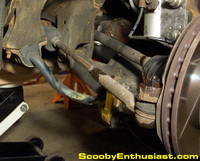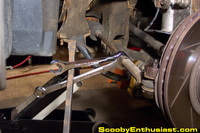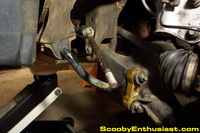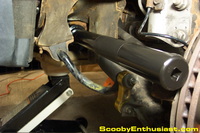You are here: Home » SUBARU Repair
SUBARU Inner and Outer Tie Rod End Repair and Replacement Procedure
June 10, 2011. Author: Lewis Werner
.
The basic SUBARU tie rod end replacement procedure, after removing the wheel, is as follows:
Photos of this procedure are available here.
The Subaru tie rod end consists of an inner tie rod end, onto which the outer tie rod end is threaded. The inner tie rod end is screwed into the steering rack.
If the tie rod end is faulty, it should really be given attention quickly, since the failure of any of these components can result in a loss of steering control.
 Remove SUBARU outer tie rod end castle nut cotter pin. Note: On rust belt area SUBARU's, the cotter pin is going to be very rusty. In these cases, I just use an air impact wrench on the castle nut and it will simply shear the old cotter pin right off.
Remove SUBARU outer tie rod end castle nut cotter pin. Note: On rust belt area SUBARU's, the cotter pin is going to be very rusty. In these cases, I just use an air impact wrench on the castle nut and it will simply shear the old cotter pin right off.
- If the SUBARU inner tie rod end is going to be replaced, it is easiest to loosen the jam nut at this time (before step 4 below). A line or flare nut wrench can be helpful in holding the jam nut and is less likely to round off the edges of the nut than a simple open end wrench.
- Remove SUBARU outer tie rod end castle nut. Some quality penetrating oil applied in advance can help the process.

- Extract SUBARU outer tie rod end from wheel bearing housing. Tapping the end of the outer tie rod end with a hammer can be helpful. A tie rod end puller can be used, but care must be taken not to squeeze the grease out of the outer tie rod end boot if the old outer tie rod end is going to be reused.

- Thread the old SUBARU outer tie rod end off of the inner tie rod end. It is a simple 'lefty loosey' thread. NOTE: It may be helpful to count the turns of the outer tie rod end when unscrewing it off the inner tie rod end. Write down the resulting turns, such as 11+1/2 turns.
If replacing the SUBARU inner tie rod end:
- If replacing the SUBARU inner tie rod end, remove the spring clamps on the inner tie rod end boot and remove the inner tie rod end boot.

- Use a screwdriver or chisel to unstake the ears on the lock washer that sits between the inner tie rod end and the steering rack. It is a tight clearance area so if it is not adequately accessible, generally this step can be skipped and the ears will let loose in the next step.
- Use an inner tie rod end tool to loosen the inner tie rod end from the steering rack. It is a normal 'lefty loosey' thread. (Note: The SUBARU procedure shows to tighten the steering gear clearance before performing this operation. I have never messed with it as the clearance is normally fairly tight anyway. I believe this step is to protect the rack from possible damage due to torsion from the torque applied when loosening the inner tie rod end.)
- Unthread the SUBARU inner tie rod end from the steering rack.
- Make sure to remove the old lock washer.
- Install a new lock washer. Some people reuse the old lock washer and rotate it so that an unused portion lines up with the grooves on the inner tie rod end. I always use a new lock washer because it is cheap and is what is recommended in the SUBARU service procedure.
- Thread the new inner tie rod end into the steering rack. The SUBARU service procedure does not specify it, but I always put some thread locker (Loctite red or blue) on the threads. Sometimes the inner tie rod end will loosen up otherwise. Yes, the lock washer will keep it from unthreading very far, but it may still damage the threads in the rack if it loosens. Loctite red will make it much harder to remove later but is less likely to loosen. Loctite blue should still provide extra holding capacity while being not impossible to loosen if the tie rod end ever needs to be replaced again.
- Reinstall the inner tie rod end boot. Use a new boot if the old one is in bad condition. It is easiest to use a new boot now, rather than have to disassemble it again to replace it later. (NOTE: Getting the inner tie rod end boot onto the rack can be tricky. The secret is silicone spray. It will slide on like butter then. Normal grease just won't do it. Thank you to nipper for this tip.)
- Make sure the springs and clamps are correct on the inner tie rod end boot.
Reinstalling the SUBARU outer tie rod end
- Make sure the jam nut is threaded onto the inner tie rod end.
- Thread the new outer tie rod end onto the inner tie rod end. If you counted the turns when threading off the old outer tie rod end, thread the new outer tie rod end the same number of turns. NOTE: It will not be perfect, but it is as close as you can get at this point. The toe should be checked after the work is complete.
- Put the outer tie rod end back into the wheel bearing housing. I like to coat the stub with antisieze to make it easier to remove later if needed.
- Reinstall the castle nut with the proper torque and procedure. The hole for the cotter pin must be visible through the castle so the new cotter pin can be installed.
- Install a new cotter pin.
- Tighten the jam nut to the proper torque.
- Now the wheel can be reinstalled, the vehicle moved and the toe checked. The toe is adjusted by threading the outer tie rod end in or out on the inner tie rod end after loosening the jam nut. By counting the turns as in the procedure above, the toe will be close, but in my experience it will still need some tweaking by one to three turns. The replacement inner and outer tie rod ends such as by Moog, or even genuine SUBARU parts, do not seem to be identical to the originals.
If you have questions or comments, please feel free to post a comment below, or visit the SUBARU repair forum.
About the Author
This article was written by Lewis Werner. It was last updated June 10, 2011 and first published November 13, 2010. If you have questions about the article, please click here to view the author's contact information including e-mail address, telephone number and mailing address.
Categories:
Sponsored Links
Post new comment